#digital abstract expressionist photography
Text

-Bright lights small cit-whoah!-
29 August 2022
4000 x 2250 Moving Picture
#abstract photography#abstract expressionism#digital abstract expressionist photography#abstract expressionist photography#abstract digital expressionist art#abstract digital photograhy#abstract art#abstract expressionist art#digital abstract photography#bratislava#cityscape#bratislava cityscape#hot august night#too hot to sleep
3 notes
·
View notes
Text

aaron in his studio, 2024
#tumblraesthetic#artists on tumblr#photography#35mm photography#my art#film photography#women photographers#digital photography#aesthetic#art#polaroid#35mm camera#filmcommunity#filmisalive#filmgrain#35mm color film#film stills#filmisnotdead#35mm film#film#medium format#fineart#art inspo#abstract expressionist art#art inspiration#drawing#painting#nan goldin#point and shoot#black and white photography
32 notes
·
View notes
Text

digital manipulation....untitled/
#art#artists on tumblr#marcelduchamp#the beat generation#manray#abstract#abstraction#artist#modern art#contemporary art#contemporary painting#contemporaryart#abstract expressionist art#abstrakshun#abstract expressionism#abstract art#the amazing digital circus#digital art#photoshop#art photography#photography#digital illustration
0 notes
Text
RELIEF PRINT SEMINAR (PARTS 1 & 2)
Any printmaking process in which the printing surface is removed to leave only the image visible on the surface is referred to as a relief print.
There are many groups of print including
Reliefs print etching
Lithography engraving
Silkscreen monoprint
Collograph
Hydro printing risoprint
Hybrid offset
Mezzotine letterpress
Digital drypoint
Relief print (woodcut linocut) involves making a mark in a surface, which can be inked, and transferring that to a different surface (paper/fabric) Whatever design is cut into the surface will not receive ink, leaving it white in the finished product.
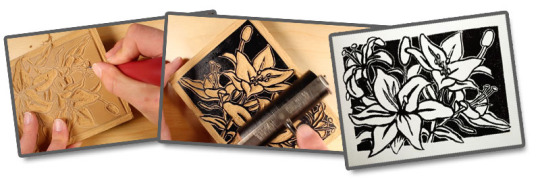
I learned that the reason relief and block printing is so popular is because of the ability to print these without elaborate and expensive machines, the ability to create and distribute multiple copies of same image and info and the ability to do it cheaply and at home.
Michael rothenstein
During the 1950s and 1960s, Michael Rothenstein developed into one of Britain's most experimental printmakers. Along with found elements like wood offcuts and metal scraps, he added contemporary 20th-century imagery to his relief prints by fusing photography with conventional woodcut and linocut techniques. His work is currently on display at several prestigious galleries.
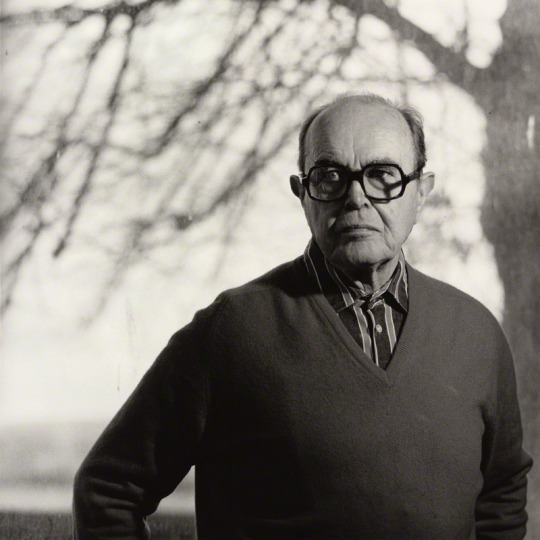

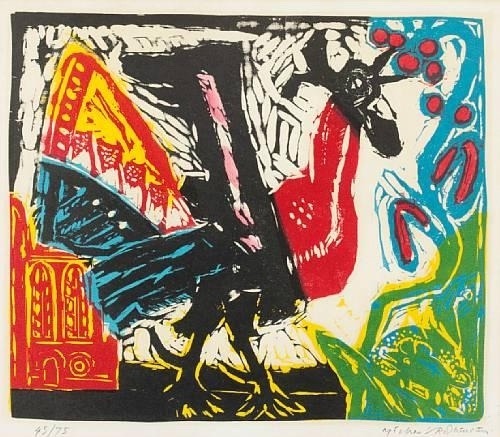
Tom huck
Tom Huck is a visual artist best known for his large scale and satirical woodcuts. His imagery draws heavily upon the influence of Albrecht Durer, Jose Guadalupe Posada, R. Crumb and Honore Daumier.
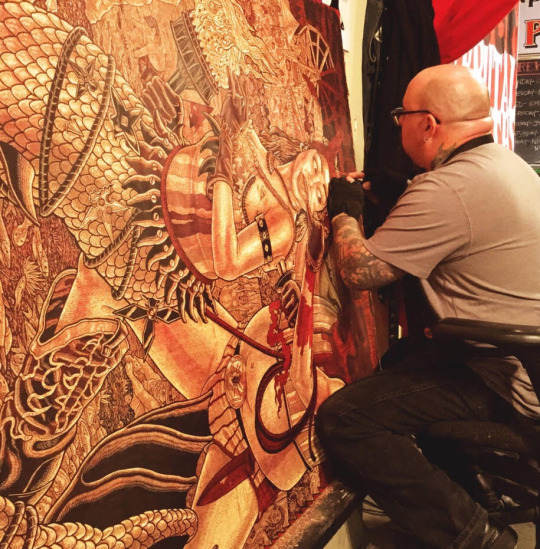
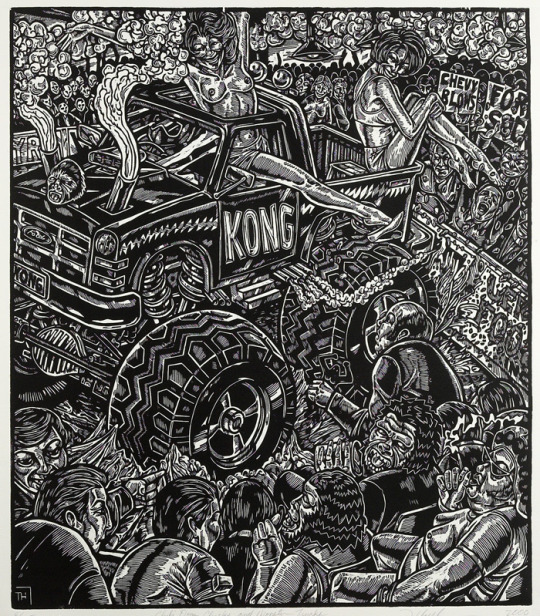

Albert Irvine
Albert Irvin is an Abstract Expressionist painter, whose large-scale works are among the most compelling and distinctive produced in Britain today. He created an extraordinary body of abstract paintings, watercolours and prints.
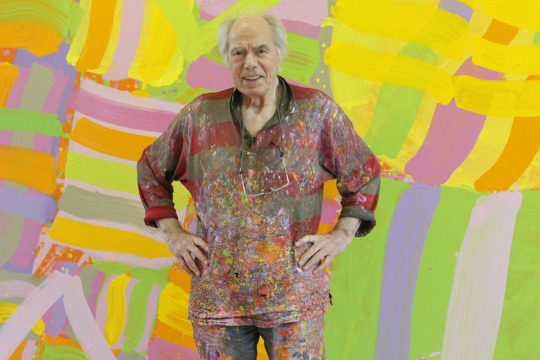


2 notes
·
View notes
Text
179 Creative Art Club Names For Different Styles And Mediums

Art clubs are a creative haven for artists, students, and enthusiasts alike, where inspiration flows, ideas are exchanged, and different styles and mediums are explored. Whether your art club focuses on painting, sketching, sculpture, photography, or any other artistic medium, having a distinctive and creative name is vital in establishing your club’s identity. It communicates the essence of your group and helps attract like-minded individuals. Here are 179 art club names tailored to different styles and mediums to spark inspiration and help you find the perfect identity for your club.
Art Club Names Based on Different Styles
For clubs that are passionate about specific art movements or styles, these names reflect the essence of those unique artistic expressions.
Classic and Traditional Art Styles
- The Renaissance Circle
- Impressionist Inspirations
- The Realism Realm
- Baroque Brushstrokes
- Neo-Classical Society
- The Romanticists
- Victorian Visions
- The Classic Creators
- Art Nouveau Innovators
- The Classic Palette
Modern and Contemporary Art Styles
- Abstract Artists Collective
- The Modernist Movement
- Pop Art Pioneers
- Cubist Creations
- Expressionist Explorers
- Futurist Frames
- Minimalist Masters
- The Surrealist Society
- Contemporary Canvas
- Avant-Garde Artists
Street and Urban Art Styles
- Street Art Society
- Graffiti Gurus
- Urban Expressionists
- The Street Visionaries
- Cityscape Creators
- The Tagging Tribe
- Mural Makers
- The Urban Collective
- Street Ink
- The Graffiti Gallery
Cultural and Heritage Art Styles
- Indigenous Inspirations
- Cultural Canvas
- Tribal Artisans
- Heritage Handcrafts
- Folk Art Friends
- Ancient Artisans
- Ethnic Expressions
- Cultural Creatives
- World Heritage Artists
- Global Art Society
Art Club Names Based on Different Mediums
These names celebrate the various artistic mediums, from painting to photography, sculpture to digital art. Perfect for clubs dedicated to a specific art form or technique.
Painting and Drawing Mediums
- The Paint Palette
- Canvas Creators
- Brushstroke Brigade
- Pastel Pioneers
- The Watercolor Wonders
- Acrylic Artisans
- Oil Painting Originals
- Ink Illustrators
- Sketchbook Society
- Charcoal Creators
Sculpture and 3D Art Mediums
- Sculpture Studios
- The Clay Collective
- Stone Shapers
- Woodcarvers Workshop
- Metal Molders
- Glass Art Guild
- The Pottery Circle
- Carved Creations
- The Chisel Club
- 3D Artisans
Digital and Graphic Art Mediums
- Pixel Pioneers
- Digital Dreamers
- Graphic Gurus
- The Vector Visionaries
- Illustrator Innovators
- CG Creators
- The Digital Canvas
- The Design Collective
- Photoshop Pros
- The Digital Art Society
Photography and Cinematography Mediums
- The Lens Collective
- Photographers Union
- Snapshot Society
- Focus Finders
- Candid Creatives
- Shutterbugs Studio
- Cinematic Visionaries
- The Film Frame
- Photography Pioneers
- Lens Art League
Art Club Names Based on Artistic Themes and Inspiration
Sometimes art clubs are centered around a particular theme or source of inspiration. These names are perfect for clubs that find motivation in nature, imagination, or spirituality.
Nature and Environmental Art Themes
- Earth Artisans
- Eco-Creators
- Nature's Palette
- Wildlife Wonders
- Botanical Brushstrokes
- Forest Friends
- Natural Canvas Collective
- Eco Art Studio
- The Nature Nook
- Green Creatives
Fantasy and Imaginative Art Themes
- Fantasy Art Guild
- Dreamscape Designers
- Imaginary Illustrators
- Surrealist Studios
- The Mythic Masters
- Magical Artisans
- Fantasy Foundry
- Imagination Innovators
- Whimsy Workshop
- Dreamweavers Art Club
Spiritual and Symbolic Art Themes
- Sacred Art Circle
- The Mystical Artists
- Zen Creators
- Symbolic Studios
- The Enlightened Brush
- Meditative Makers
- The Chakra Collective
- Soulful Studios
- Sacred Symbolists
- Spiritual Artisans
Art Club Names for Kids and Youth Art Clubs
For younger artists who are just starting to explore their creativity, these fun and lighthearted names are perfect for kids’ and youth art clubs.
- Mini Makers
- Kiddo Creators
- Little Art Legends
- Youthful Yarns
- The Tiny Easel
- Artistic Adventurers
- Junior Brushstrokes
- Creative Kids Collective
- The Colorful Kids Club
- Budding Artists Society
Art Club Names for Community and Collaborative Art
Art clubs focused on community, collaboration, and social change often reflect their values in their names. These names are ideal for groups that believe in the power of art to bring people together.
- The Creative Collective
- Art for Change
- Community Canvas
- Collaborative Creators
- Artistic Alliance
- The Unity Studio
- The Peaceful Palette
- Social Artisans
- The Art Impact Group
- Unity Through Art
Art Club Names for Experimental and Mixed Media Art
For art clubs that love to push boundaries and explore unconventional materials, these names emphasize experimentation and creativity without limits.
- Mixed Media Masters
- The Experimenters
- Boundary Breakers
- Creative Fusion
- The Innovators Art Studio
- Offbeat Artists
- The Eclectic Easel
- Art Beyond Limits
- Multimedia Mavericks
- The Explorers Collective
Art Club Names for Passionate Artists
For clubs that are all about passion and the pure love of art, these names reflect dedication, creativity, and the joy of creating.
- Passionate Painters
- Artful Hearts
- The Creative Souls
- Easel Enthusiasts
- Dedicated Designers
- Crafted with Passion
- Heartfelt Artisans
- The Devoted Canvas
- Inspired by Imagination
- The Love of Art Society
Art Club Names for Cultural Art Exchanges
If your art club focuses on exploring different cultures through art, these names highlight diversity, global perspectives, and the beauty of cultural exchange.
- Cultural Canvas Collective
- Global Art Exchange
- The Worldly Artists
- Art Beyond Borders
- The International Palette
- Cross-Cultural Creators
- The Global Gallery
- Artistic Ambassadors
- The Diversity Studio
- Cultural Fusion Creations
Art Club Names for Inspirational and Uplifting Art
For art clubs that aim to inspire and uplift, these names reflect positivity, creativity, and a desire to spread joy through art.
- Inspired Artists Society
- Creative Kindness Collective
- Art with Heart
- The Uplift Studio
- Joyful Creations
- The Inspiration Nation
- Positive Palette
- **The Dream Makers
- The Inspiration Brush
- Radiant Artisans
- The Encouragement Easel
- The Hopeful Creators
- Art of Positivity
- The Joyful Strokes
- Colorful Spirits
- Artful Optimism
- Happiness Through Art
- Inspiration Imaginarium
- The Vibrant Visionaries
Conclusion
Selecting the right name for your art club is an exciting opportunity to showcase your club's vision, style, and passion for creativity. Whether your focus is on a specific artistic style, medium, or theme, or if your club is a place for experimental work, cultural exchange, or simply spreading positivity through art, your name will help set the tone for the community you are building.
The perfect art club name should be a reflection of your group’s core values, offering potential members a glimpse into what makes your club unique. It’s not just about picking a catchy name – it’s about expressing your identity and purpose through the power of words.
Read the full article
0 notes
Text
Hermann Lederle
Critically admired german artist Hermann Lederle is most prominent for his PIXEL and BLOTS painting and more recent ADAPTATION series. His works have shown in numerous exhibitions around the world, and his artistic production is particularly unique and recognizable. Although initially the impression is abstract, Lederle's works feature geometric elements that compose, as a whole, figurative elements, bringing to mind that of the abstract expressionists.
Los Angeles artist Hermann Lederle is known for his innovative BEAUTIFUL CHAOS abstract canvas scapes and unique BREAKAWAY layered PIXEL painting. Blurring the boundaries between paint-scape and landscape reality, and between the paint and its intended object, the work combines geometric abstraction and pure color concept to explore a new ethereal thematic. Through a PILLING of dotted lines and multitude of hyper-glow colors - as if the artist intends to assault the surface with micro-nuclear forces, Lederle constructs a next generation art-scape.
Upon graduating from Karl Friedrich School Mannheim for humanist and classic studies in Germany, Lederle re-directed his career path. His early apprenticeship training in photography inspired him to seek a formal continued education in the Fine Arts, namely filmmaking and painting at the San Francisco Art Institute.
San Francisco became his new residency for the next years until graduating with a BFA, followed by five years establishing himself as a painter in the thriving arts district of Tribeca in downtown New York City. It was there, Lederle began to formulate his own visual language to express his concepts and ideas through the lens, on canvas and on the film screen. Exemplifying the artist’s interest in the interaction between art and film and creating an additional link to 21st century web based digital art, Lederle's painting strives to wipe clean the slate of conventional notions of image construction.
Lederle's PIXEL series, first shown at Media Rare Gallery in Hollywood suggests a kind of Cubism for the digital age. His work as a filmmaker cross-pollinates in subtle, oblique ways. The idea of pixel paintings originated when working with digital images. “It was a discovery. We may have been seeing this way unconsciously since human beings had eyes, but now that we know we can zoom in on something, and then zoom out and see the whole picture, it becomes an awareness we can use to appreciate the pixilated version. Kind of like a primal, pre-conscious experience that relates to the era of technology."
Lederle's FOOTPRINTS ON SNOW series entails a two stage process, where a graduated color is applied with a tractional brush allowing for the distinct qualities of its stroke to emerge. The second stage is executed with a painter's knife often with ostensibly contradictory linear shapes and lines, imbuing it with the properties of rival perceptions, irreversible like footprints, taking place within the canvases.
More recently, in his so-called ADAPTATION series, those vertical bands consist of the vivid and expressionistic decades-old paintings that Lederle has painstakingly hand-cut and then collaged onto the canvas, leaving just enough space for original marks to show through as interstices of the canvas. Punctuated with a stop and go rhythm, the work reigns in the artist’s prior unbidden flourishes and lays bare the source of artistic inspiration, simultaneously suggesting themes of evolution as they relate to Lederle's own practice and reflections on art history.
His latest works in submission on the occasion of IN SPRING Exhibition 2024, recall the BLOTS-pointillism of the neoimpressionists. When purposely set against a SCHIENA SCURA - dark FOAM bubbles, the painting is calling out a messy, un-ordered free floating imagery of some scenery not quite in focus and frozen in a still frame, although its kinetic forces relentlessly pushing up against its limits. The experimental composition of primal shapes and lines striving for a creative expression of artificial, nearly molecular spaces in another dimension and direction. These images take time to absorb, asking you to invest and trust, not speed through in a frenzy. A new-dimensional structure slowly emerges transcending past traditional geometrics.
Hermann Lederle's work has been exhibited in the United States in New York, Los Angeles, San Francisco and Canada, Germany, Italy, France and Hungary. A body of his work is in consignment at galleries, including DSV Kunstkontor Stuttgart, HPH Siebdruck Echterdingen Germany, Media Rare Gallery Los Angeles, Court Gallery New York, Lawson Galleries San Francisco, Friedman Guinness Gallery Heidelberg, and in private collections of Ringo Starr, Eric Stolz, Cal Zecca, Gabor Csupo.
Lederle lives and works in Los Angeles, California.
Previous notable exhibitions took place at M.A.D.S. Art Gallery ANDRENOCHROMO FOR DINNER Milan Italy 2022, ART KARLSRUHE HPH Special Serigraph Exhibition Germany 2020, Silverman Studio Hollywood 2017, Vertiva Stuttgart Germany 2015, Arthea Galerie Mannheim Germany 2015, Frank Pictures Gallery Santa Monica 2012, Solaris Gallery Los Angeles 2005, FP Gallery Los Angeles 2005, Media Rare Gallery Hollywood 2001, Lawson Galleries San Francisco 1987 and Court Gallery New York City 1986.
0 notes
Text
"Do you want to know what hell looks like? There is one person who can give you an answer, and his name is Zdzislaw Beksinski.
Name: Zdzislaw Beksinski
Birthdate: February 24, 1926
Death date: February 22, 2005
Profession: Painter, Photographer
IMDB Profile: [https://m.imdb.com/name/nm3561030/?ref_=nv_sr_srsg_0]"
"My paintings do not have any symbolic meaning," said Dezyderiusz Beksinski about his art. He even refrained from giving names to his paintings, stating, "I merely transform imagination into reality, painting in a way that captures dreams." If we take his words into account, then aren't the paintings below representing nightmares?


He never received any formal art training, but in the face of his natural talent, any technical training becomes insignificant. Beksinski is indeed a genius.
He never visited museums, paid no attention to art world trends, and didn't particularly admire any great artists. While painting, he always listened to classical music and occasionally rock music. He claimed that his inspiration came from music. He insisted that his works had no meaning, which is why the majority of them remained untitled. He allowed the audience to interpret each piece according to their own understanding.
Eerie, terrifying, and bone-chilling... I believe these adjectives might come to mind when viewing his works, despite their hellishly dark colors. However, in real life, Beksinski was a very sunny, cheerful, and pleasant person. Those who had the chance to chat with him praised his wisdom and humor, and nearly all biographers described him as a modest and shy music enthusiast. Due to his dislike of socializing, he avoided any activities that could disrupt his daily life, including his own exhibitions. In fact, he never attended the opening of any of his own exhibitions.
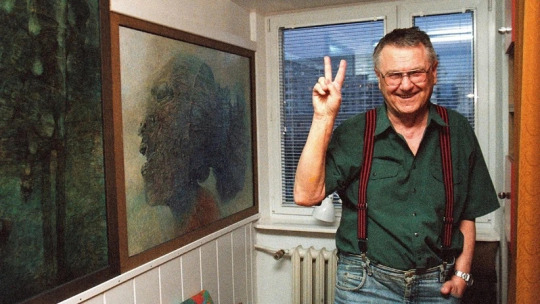
Doesn't he look like someone who would create such paintings? The detailed scenes of death and decay, graveyards filled with skulls and skeletons, became Beksinski's signature. Some observers believe that he was born shortly before the outbreak of World War II, and his entire childhood and adolescence were spent in the midst of war, leaving a profound impact on his subconscious mind.


Just appreciating aesthetics without attempting to understand their emotional significance, that’s what he said, and I totally agree. Here are of my favorites:
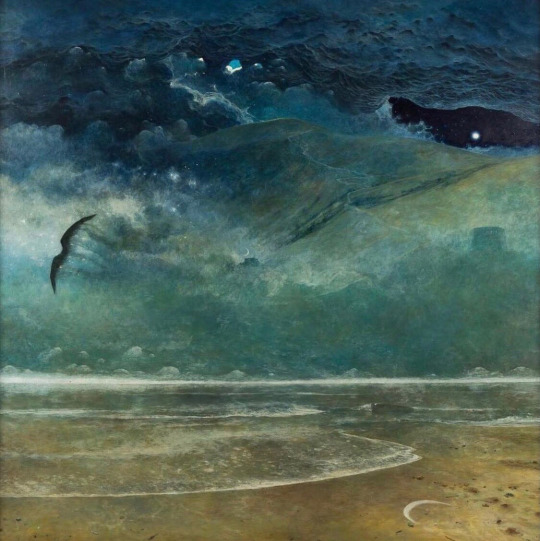

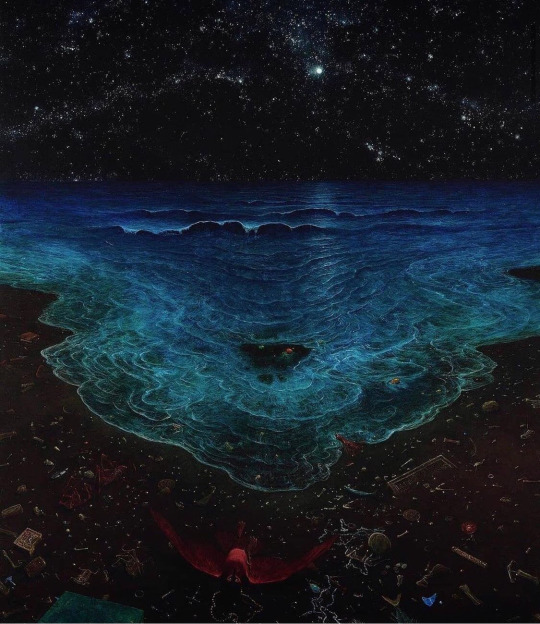

In a 1997 interview about symbolism, Beksinski said, "When I create, simple associations come up, a collision of several objects, and a scene emerges in my mind..."
"...All the views about painting dreams come from journalists. In my life, maybe I tried to paint a dream—a fragment of my youth. But I never use dreams, and I never try to find out why I should paint a bird sitting on someone's shoulder. It can happen spontaneously, just like in a dream. I simply create a completely random dream. If it fits, I put it there..."
"...I never wonder why I write 28 or 2 on a painting. I do a lot of such meaningless acts."His words seem to flicker in my mind like frames from a movie, feeling the inspiration he experienced while painting, connecting to frequencies that don't belong to this world.
Beksinski's works can be divided into two periods. The first period is generally considered to have expressionistic and Gothic realism elements, with a strong style of "utopian realism" and surreal architectural themes, resembling apocalyptic scenarios. In contrast, his later works, starting from 1990, exhibit a more abstract style.
In the late 1990s, Beksinski became interested in computers, the internet, digital photography, and visual arts, and he focused on these media until his death. In 1998, his wife of 47 years passed away from cancer, and a year later, on Christmas Eve, his son committed suicide. Beksinski was the one who discovered his son's body, and he was devastated and unable to accept reality.
On February 21, 2005, Beksinski was found dead in his Warsaw apartment with 17 stab wounds, two of which were fatal. He was murdered by 19-year-old Robert Kupiecki, the son of a longtime caregiver and a friend of his son's. The motive for the murder was Beksinski's refusal to lend money (reportedly around $100). On the day of his death, February 21, 2005, Beksinski completed his final artwork.
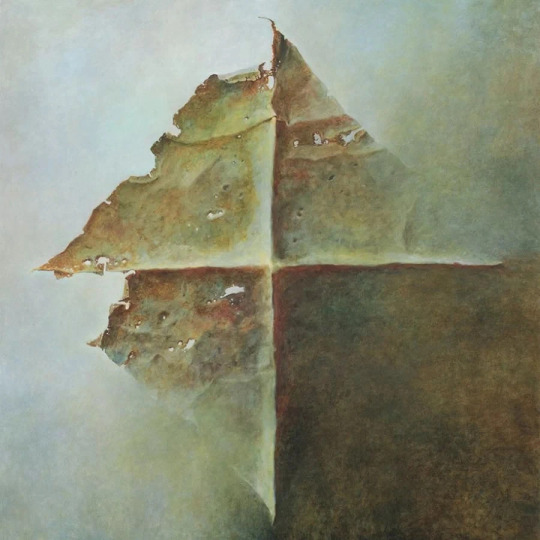
Ref:
1.The Dystopian Surrealism of Zdzislaw
Beksinski. by ERRIKA GERAKITI,4 JULY
2022.
2.The Wonders of Zdzislaw Beksiński by Jane Frank,
1 note
·
View note
Text
Visual Art
Visual art is a broad and diverse field that encompasses various forms of creative expression, ranging from traditional paintings and sculptures to contemporary installations and digital artwork. It is a means of visually communicating ideas, emotions, and experiences through the skilled manipulation of visual elements such as lines, colors, shapes, textures, and composition.
One of the key aspects of visual art is its ability to evoke emotions and convey messages without the need for words. Artists use their unique perspectives and creative techniques to capture the essence of their subjects or explore abstract concepts. Whether it's representing the beauty of nature, depicting human experiences, or challenging societal norms, visual art has the power to provoke thought, inspire dialogue, and evoke deep emotional responses in viewers.
Visual art is a reflection of cultural diversity and historical context. Throughout history, artists have been influenced by their surroundings, cultural traditions, and societal movements, resulting in a rich tapestry of artistic styles and movements. From the Renaissance masters to the abstract expressionists and contemporary multimedia artists, each era brings its own unique artistic vocabulary and visual language.
The beauty of visual art lies in its diversity and inclusivity. It encompasses a wide range of mediums, including painting, sculpture, drawing, photography, printmaking, ceramics, and more. With the advent of technology, digital art has also emerged as a prominent form of visual expression, incorporating elements of computer-generated imagery, animation, and virtual reality.
Visual art is not only a means of self-expression for artists but also a powerful medium for social commentary and cultural critique. Artists often use their works to shed light on social, political, and environmental issues, challenging conventional beliefs and stimulating conversations. Art has the ability to provoke introspection, question societal norms, and inspire change.
#graphic design#visual art#artist#digitalart#digital illustration#artists on tumblr#digitalmarketing#drawing#digital sketch
1 note
·
View note
Text
Wolfgang Tillmans
Since the early 1990s, Wolfgang Tillmans has pushed the boundaries of the photographic medium. Challenging the indexical nature traditionally associated with photography, his abstract and representational photographic bodies of work each in their own way put forward the notion of the photograph as object—rather than as a record of reality.
Tillmans manipulates light as though it were painterly pigment; the result is a photographic form of abstraction that possesses something of the close palpability of bodily presence. Although divorced from the camera, these photographic images nonetheless operate within the intersection between analogue and digital processes. Art historically, this elusive painterly quality is reminiscent of the powerful colour depictions of the Abstract Expressionists.
By exposing photographic paper in the darkroom to light and chemicals, chance plays a vital role the creation of these works. As Tillmans has explained: “what connects all my work is finding the right balance between intention and chance, doing as much as I can and knowing when to let go, allowing fluidity and avoiding anything being forced”. Ultimately Tillmans does not seek to depict reality, rather, he interprets and recreates it, working with light to create an alternative actuality, a way of creating photographic images free from pedagogy and preconception.
In 2000, Tillmans was the first photographer to receive the prestigious Turner Prize.
📷
1. Wolfgang Tillmans, Its Only Love Give It Away, 2018
2. Wolfgang Tillmans, Freischwimmer 102, 2004, Christie’s Auction
3. Wolfgang Tillmans, Freifbar 26, 2014, Sotheby’s Action
4. Wolfgang Tillmans, Freifbar 27, 2014, Phillips Auction
5. The artist Wolfgang Tillmans, Sleek Magazine

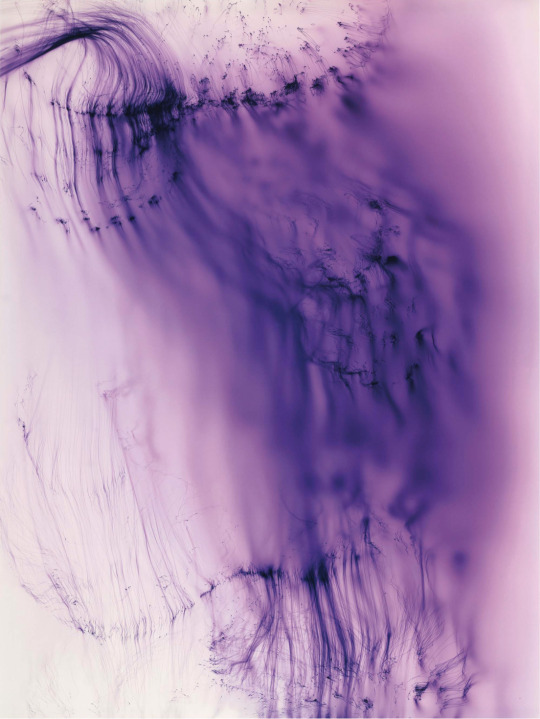
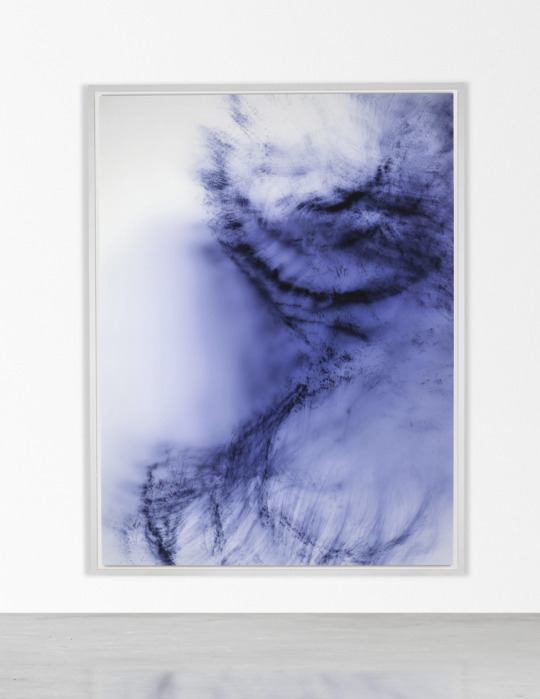


#WolfgangTillmans#Artist#ArtWords#Beautiful#Art#ArtPhotography#FineArtPhotography#Abstract#Photography#PhotographyExhibition#DavidZwirner#MoMA#Nature#NaturesPalette#Pigments#NaturalPigments#Colour#Chroma#ColourPalette#ColourStudies#ColourTheory#TheColourProject#London
0 notes
Photo



#abstract photography#abstract photo art#abstract expressionism#abstract expressionist photography#art#digital manipulation#contemporary abstract#contemporary photography
1 note
·
View note
Text

-Counter/Counter Clock/Wise...Baby!-
9 March 2024
Moving Picture 1769 x 1739
#digital art#digital photography#digital abstract art#digital abstract#abstract art#abstract photography#abstract expressionism#digital photo art#digital abstract expressionist photography#digital abstract expressionist art#digital abstract expressionism#spin you like a top#right round baby right round
0 notes
Text

#tumblraesthetic#artists on tumblr#photography#35mm photography#my art#film photography#women photographers#digital photography#aesthetic#art#abstract#abstract expressionism#abstract expressionist art#abstraction#collage#mixed media#multimedia#art inspo#art inspiration#fine art#inspo#inspiration#35mm camera#point and shoot#35mm color film#35mm film#35mm#black and white photography#for sale#art for sale
23 notes
·
View notes
Photo

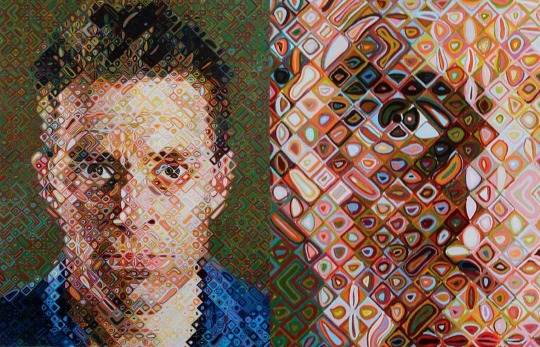
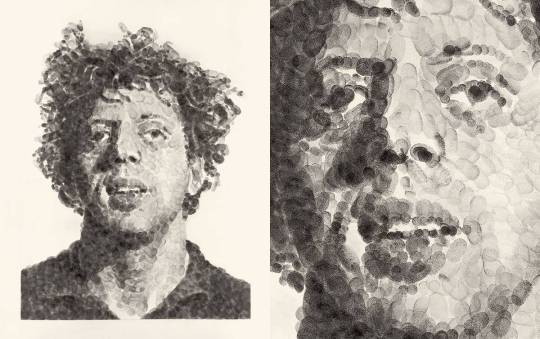

Charles Thomas Close (July 5, 1940 – August 19, 2021)
At the end of the 1960s, a period when formalist abstraction and Pop Art dominated the contemporary scene, Mr. Close began using an airbrush and diluted black paint to create highly detailed nine-foot-tall grisaille paintings based on mug-shot-like photographs of himself and his friends.
Chuck Close’s approach to the canvas was inspired by the non-hierarchical, all-over surface of American painting epitomized for him by the work of Abstract Expressionists such as Jackson Pollock. After taking a picture of his subject, Close makes photographic prints that he uses to transfer the images to canvas. Utilizing a technique devised by Renaissance masters and adapted by contemporary billboard painters, Close overlays a working print with a numbered and lettered grid, and then reproduces the image block by block.
Mr Close also applies his creative process through a wide range of techniques and materials including acrylic, oils, watercolor, drawing, pastels, printmaking, collage, tapestry, photography, CYMK color separations, digital imaging, rubber stamps, fingerprints, paper pulp and string.
Chuck Close’s “Big Self-Portrait,” painted in 1968, Acrylic on canvas, 107-1/2 x 83-1/2 x 2 inches unframed, Credit...Chuck Close, via Pace Gallery.
'James' with close-up detail (2004), Screenprint (62"x48").
'Phil Fingerprint / Random' with close-up detail (1979), Fingerprints with stamp-pad ink (40"x26").
A portrait of the artist Kara Walker, Oil on canvas. 276,2 x 213,4 cm. Pace Gallery, New York.
#art#painting#chuck close#rip#rip chuck close#hyperrealism#fingerprint#surreal#blocks#bigselfportrait#mosaic#james#screenprint#iconic#phil#ink#charles thomas close#photorealism#kara walker#phillp glass
104 notes
·
View notes
Photo

THE FRIDAY PIC is a page from Lucy Hogg’s “Monkey Painter,” the digital slide show (cum book, cum Instagram feed) that Pan Wendt has curated into his latest show at the Confederation Center for the Arts.
Feel free to ignore the comments on it that follow, because I admit they can’t have been written with the impartiality I normally aim for when I talk about art.
To steal a line from the poet Wendy Cope, Lucy Hogg is my favorite artist—and I like her artworks, too.
I think her “Monkey Painter” really stands out from most of the art I’ve seen over recent decades. I’m not sure I can think of anything quite like it. (Cue a dozen readers who remind me of similar—or not-really-so-similar—works I’ve forgotten.)
The 216 slides in “Monkey Painter” tell the story of Lucy’s life as an artist, from the moment she started art school, in 1977, to the moment, a bit more than a decade ago, when she gave up painting for photography (and for slide-show memoirs). Each slide consists of one of her artworks, shown to the left, and, to the right, a short bit of storytelling about the moment in her career it came out of. (Excerpts from the work are here.)
Lucy has had a career that’s pretty typical of most of our contemporaries
who’ve managed to make a living as professional artists: a couple of degrees in the field; decades of production in various modes and styles; a respectable number of shows in both non-profits and galleries; a handful of sales that have just about paid for art supplies while food and shelter have come from gigs as a teacher. But even though this kind of artist’s life is typical, it has been almost completely neglected in the stories we tell ourselves about artmaking, or that our art has ever depicted. Those are almost completely dominated, to this day, by heroic tales that center around the kind of superstar artists who get profiled by art writers. (Mea culpa.)
“Monkey Painter” does a lovely job refocusing our attention on how most of today’s contemporary art really ends up getting made, and on the kind of quotidian challenges—social; material; artistic—that confront the people who make it. Lucy gives us a “Ballad of Sexual Dependency” for all the many artists who have never quite lived, or wanted to live, Nan Goldin’s vie de bohème. And like Goldin’s great work, the art of “Monkey Painter” inheres in the artistic life that’s depicted and also in the particularities of the images that depict it—which, as it happens, are also the art that the life’s built around.
One of the best things about Lucy’s project is that it doesn’t try to elevate the ordinary, Vermeer-wise. Instead, it allows us to take pleasure in its true ordinariness—or rather to understand the space that the ordinary, the truly ordinary, takes up in life and art. The slide show presents Lucy’s artworks in straightforward reproduction, without seeming to special-plead for their excellence. The texts beside them are equally straightforward and foursquare: Rather than commenting on the reproduced works, or trying to justify them, they just lay out the personal and professional circumstances that governed their making, at least as Lucy now remembers those moments. The storytelling is wildly understated, with a very quiet, very Canadian wit that hints at a tongue that might be thinking of heading into a cheek, but then decides that would be too showy. (The first line of the work: “In 1977 I became an Abstract Expressionist.”) I’m especially impressed by the exquisite balance and tension between image and text, such as I’ve rarely come across in other artworks. (The layout of the copy, different for each text/image pairing, subtly underlines that relationship.)
And even though it’s possible to read “Monkey Painter” as almost completely informational, even anti-retinal—as purely “ostentional,” to use a favorite word of mine—esthetics enter by the back door through all the works on display. But because of the vast variety of forms and styles that we’re presented with, spanning almost exactly three decades, we get a clear sense that any aesthetic parti pris has been put in doubt. The whole artistic enterprise, as represented by the image on the left side of each slide, becomes the inevitable product of, and maybe no more important than, the daily life-as-an-artist described in the text on the right.
With “Monkey Painter,” Lucy comes off as an appropriation artist whose sources happen to all be her own earlier works, many of which are themselves appropriations of Old Master paintings—giving us appropriation, cubed. This makes for a strange time-bending effect, as we negotiate the relationship between the Lucy of 2022, author of the appropriational “Monkey Painter,” and all the earlier versions of that same artist (often appropriational) that she presents to us. Lucy’s slide show creates a hall of mirrors that is so carefully calibrated and camouflaged that we can only barely tell we’re inside one. (Artwork image courtesy the Blake Gopnik Collection.)
6 notes
·
View notes
Text
additions to ongoing research
[a small glossary of things I thought were important to look further into after my initial research]
Eroticism
Eroticism is a quality that causes sexual feelings, as well as a philosophical contemplation concerning the aesthetics of sexual desire, sensuality, and romantic love. That quality may be found in any form of artwork, including painting, sculpture, photography, drama, film, music, or literature. [wikipedia]
Erotic art is truly an image without context, a naked and pure image that transgresses the norm by making the private, the intimate and the sexual public, expressing the infinite power and beauty of the subconscious. [https://edition.cnn.com/style/article/erotic-art-history/index.html]
Abstractionism
Abstractionism is the theory that the mind obtains some or all of its concepts by abstracting them from concepts it already has, or from experience. One may, for example, abstract 'green' from a set of experiences which involve green along with other properties. [wikipedia]
Abstract art is art that does not attempt to represent an accurate depiction of a visual realitybut instead use shapes, colours, forms and gestural marks to achieve its effect. [https://www.tate.org.uk/art/art-terms/a/abstract-art]
Eastern mysticism.
Eastern mysticism or Eastern spirituality is a broad and largely Western concept summarizing and sometimes amalgamating mystic traditions of the Middle East, the Indian Subcontinent and the Far East, a separate realm from Western mysticism. [https://psychology.fandom.com/wiki/Eastern_mysticism]
Surrealistic-expressionist
Expressionism - A movement in the arts in which the artist did not depict objective reality, but rather a subjective expression of their inner experiences
Surrealism - An artistic movement and an aesthetic philosophy that aims for the liberation of the mind by emphasizing the critical and imaginative powers of the subconscious.
[https://www.askdifference.com/expressionism-vs-surrealism/]
straigh/ pure photography
Straight photography emphasizes and engages with the camera's own technical capability to produce images sharp in focus and rich in detail. The term generally refers to photographs that are not manipulated, either in the taking of the image or by darkroom or digital processes, but sharply depict the scene or subject as the camera sees it.
[https://www.theartstory.org/movement/straight-photography/]
pictorialism.
Pictorialism, an approach to photography that emphasizes beauty of subject matter, tonality, and composition rather than the documentation of reality.
[https://www.britannica.com/technology/Pictorialism]
photography magazine. - interview.
[I'm not sure what magazine the interview was published under so I can not find the interview]
0 notes
Photo
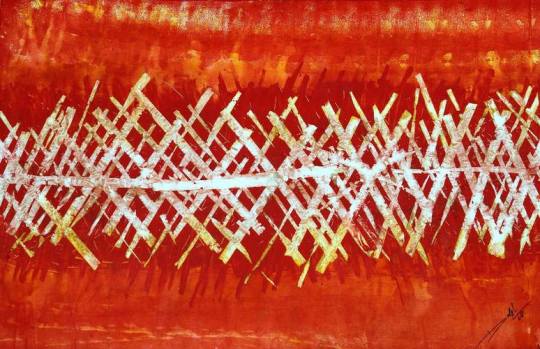
GOLDEN PATH - TO SUCCESS, Baljit Chadha
MY ABSTRACT ART BESIDE FLOWERS FLOWERMAN CREATED A WORLD RECORD http://baljitchadha.blogspot.in The exhibition with the most paintings of flowers in the world This certificate is given by WORLD RECORD ASSOCIATION / LIMCA BOOK OF RECORDS-INDIA -2014 Baljit-chadha.artistwebsites.com http://www.youtube.com/edit?ns=1&videoid=fCTt1B51fJA http://www.1wra.org/index.php/Worldrecord/detail/id/1241 MY NEW SERIES ZEN MOKSHA FLOWERS/ MANN FLOWERS/MIYOKO FLOWERS /BALJIT’S IKEBANA Dear BALJIT CHADHA, We were thrilled to include your work in the digital display at the Louvre on July 13th as part of the Microphotography Collection. It was magnificent to see work from photographers representing over 191 different countries displayed together at the most esteemed museum in the world. Thank you for being a part of it! SeeMe Exhibitions OFFICIAL LETTER OF RECOGNITION Dear BALJIT CHADHA, It's been an honor to show your photography as part the Fifth Annual Exposure Award. The work of this year’s project has been extraordinary, viewed by over five million photo enthusiasts from around the world. Additionally, your photograph was included in a digital display of images presented at the Exposure Award Reception at the Louvre. Your photography was included in the Microphotography Collection and was presented at a private reception at hosted at: Musee du Louvre 75058 Paris - France July 13th, 2015 See Me Exhibitions OFFICIAL LETTER OF RECOGNITION Dear BALJIT CHADHA, It's been an honor to show your photography as part the Fifth Annual Exposure Award. The work of this year’s project has been extraordinary, viewed by over five million photo enthusiasts from around the world. Additionally, your photograph was included in a digital display of images presented at the Exposure Award Reception at the Louvre. Your photography was included in the Microphotography Collection and was presented at a private reception at hosted at: Musee du Louvre 75058 Paris - France July 13th, 2015 A PURE HEAVENLY GIFT FOR YOU FRIENDS N RELATIVES • THESE ZEN-MOKSH FLOWERS ARE CREATED WITH A SENSE OF GIVING INNER PEACE,TRANQUILITY, HAPPINESS, SOLACE AND A SENSE OF FULFILMENT, ONENESS WITH THE SUPREME. • I HAVE TRIED TO BRING THEASE ELEMENTS IN MY PAINTINGS,THE FLOWERS YOU SEE DON’T EXISTS, THE MOVMENTS OF MY HANDS,FLOW OF COLORS ARE THE GIFT OF ALMIGHTY GOD. • ZEN-JAPANEASE ZEN IS A SPIRTUAL INSPIRATION; THEY ARE PURE EXPRESSION OF ARTIST’S SPIRITUAL AWARENESS. JAPANEASE ZEN ART HAS ALWAYS BEEN MEANT TO TOUCH PEOPLE FAR AND WIDE. ZEN PAINTINGS ARE OF GREAT POWER, PURE, AND TOUCHING DEEP IN THE HEART, MIND AND SOUL. • MOKSHA- Freedom from life circle. Moksha is attained by dis identification with the body and mind, which are temporary and subject to change, and realization of our true identity Moksh is positive concept in two important ways. First it stands for the realization of the ultimate Reality, a real enlightenment. The mukta is not just free from this or that, It is the master of sense and self, fearless and devoid of rancor, upright yet humble, treating all creatures as if they were he himself, wanting nothing, clinging to nothing. In Sikhism one rises from the life of do’s and don'ts to that of perfection — a state of "at-one-ment" with the All-self. Secondly, the mukta is not just a friend for all, he even strives for their freedom as well. He no longer lives for himself, he lives for others. • APPRICIATIONS • Very interesting work Baljit, the spontaneity, the original technique and the spiritual journey! • i hear music from your flower paintings. What a happy movement! • Baljit! I appreciate that! You have a grand body of work here that shows me some Van Gogh, Miro and Monet and countless others within your style and creativeness. A magnificent talent to behold and appreciate! Keep it up! • I like the original exposition of your beautiful artwork. • Beautiful, cheerful, great colors! • Very fine expressive all Your floral art, not usual • Simply beautiful .It is with great pride and pleasure that I am FEATURING your artwork this week on our special edition of our TOP FEATURES on the Wisconsin Flowers and Scenery Homepage. Your work shows expertise and love in the presentation of this fine art piece. Thanks much for sharing your works with us and being a member of our family of friends and fine artists in our WFS group. Aboard. Liked, Forever .This series is enchanting Baljit, all wonderful visions. Masterful use of your colors creating serene energy. .Baljit, I love these stalks of beauty is a true honor and privilege to FEATURE this creative and wondrous piece of art work on the WFS site, from one of our honored and prestigious members. This awesome piece of beauty is what we are looking for to promote and let others see, including other artists and potential customers, as your works are some of the Best of the Best in my Book! Thanks much for sharing this beauty with us. Liked Forever, Elvisty and love the colors of the floral stems. • • PROFILE • Baljit Singh Chadha- LOVES PHOTOGRAPHY AND PAINTING • • I grew up as a curious, investigative child helped by my parents’ encouragement to explore and to learn without fear and hesitation. The wonder and awe in God’s creation always held me spell bound. I ploughed my curiosity through love of creation and creativity. At a young age of nineteen years I sailed to a land called Japan that has for long centuries been spiritually bound with India. Like a sleepy rose the petals of my creativity opened as I drank like a honey-bee the nectar of ancient and highly evolved culture of Japan. Japanese art of painting is high meditation in feel and in expression. My Japanese godmother Ms Otha Miyoko a great Japanese artist was my first teacher. She affected my style and expression early on. My journey in art continued and I evolved a style of art that has minimal gap in feeling and expression. Rapidity and quickness of expression in my art comes from the well of inner spirituality. My art is not planned, thought-out and cerebral it is based on spontaneity. Abstract Expressionism is a wider term and my art follows it in variegated dimensions. In my art I experiment with different painting instruments and techniques. My dependence on brushwork is rather limited. I frequently and freely use spatulas, wooden sticks, masking, and sand-mix, push bottles and what comes handy in the moment. I use acrylic with mix media. I have developed acrylic based glazes that were possible earlier only with oil paints. The glazes impart a charm similar to enamel glazes. I created a new technique called ( FLOAT ON COLORS). My art journey finds depth and width in continuous experimentation, forays into the unknown and choosing challenging metaphors of expression. I did an installation (Wall of Divine flowers) with 12000 painting on 12-12-12-12hrs-12mnts-12sec at Zorba in New Delhi and donated entire collection to Smile Foundation New Delhi, for a girl child education. Where my art journey will take me next I leave to higher forces. Presently I offer you ZEN MOKSHA FLOWERS /MANN FLOWERS/MIYOKO FLOWERS AND WALL OF HEAVENLY FLOWERS as my next creations. Group Shows;- Newyork, Singapore, • Canvas Art Gallery , Nehru Place, Delhi 2006 • Studio Vasant, Vasant Vihar New Delhi, 2006, 2007 • Prabhat NGO, New Delhi, 2007 • Nithari, Canvas Art Gallery, 2007 • Sahaj Sankalp, Habitat Centre, New Delhi , 2008 • Aspiration, Charity show at Epicenter Gurgaon, 2008 • New Finds, Singapore, 2008 • Group Show at World Fine Art Gallery, New York, 2008 • Reverberation Habitat Centre, New Delhi, 2008 • Art for Prabhat Presents 'The Eternal Circle' MAY-2009 • Art Ponixs Mumbai-2013 Solo Show • Studio Vasant, New Delhi, 2006,2007 • Studio Vasant, New Delhi 2008 • DLF Mall, Saket, New Delhi 2009 • STUDIOVASANT,NEWDELHI • STUDIOVASANT,NEWDELHI-2011 • STUDIOVASANT,NEWDELHI-2012 • WALL OF DEVINE FLOWERS-ZORBA,NEWDELHI 2012(world record) • WALL OF EXOTIC FLOWERS-EPI CENTRE GURGAON-2013 • HOME& interior expo, EPI centor.GURGAON-2013 • Independence day Celebration-EPI CENTRE-2013 • Art-Phonix-NEHRU CENTRE MUMBAI-2014 Artist friend Baljit S. Chadha has a lasting honeymoon with flowers in his artistic expression. He paints sometimes with frugality of a Zen master. I can understand that as he had his early training in painting in Japan where he lived and studied as a teenager and had the benefit of the tutelage of great Japanese masters. But his present series on flowers nonplussed me with wonder and joy. He has in the present works a new dimension and a new personality of flowers that I have not seen before. This is because he has distilled the expression from his inner joy and happiness that is the essence of flowers per se and not from their forms. His flowers have a nearly expressionistic, abstract persona. He uses a watercolour like free flow of colour and tonalities to invest his work with a sensual poetry. His works are acrylic on paper and therefore amenable to idiosyncratic overflows that lends a fresh charm to his oeuvre. Another landmark quality of Baljit’s new works is that they are rendered in fiery shiny glazes. As we know glazes are traditionally done in oil paint medium. But Baljit has worked them with acrylic colour and without the use of pure impasto. The colours diluted with water float and embrace each other and still have lustrous intensity. Baljit Chadha has created a fresh stylistic edifice and his creative expression jumps from the visible-familiar to spiritually felt flowers in a divine Eden. Viktor Vijay Kumar Director Curator European Artists’ Association Germany • ART IS IMAGINATION/ART IS DREAMING/ART IS INOVATION/ART IS THINKING/ART IS CRAETIVITY/ART IS EMOTIONS/ART IS SUPPORT/ART IS COMBINATION OF MATERIALS/ART IS CONCEPT/ART IS TO DO SOME THING DIFFERENT/ART IS TO EXPLORE AND ART IS FOR EVERYONE TO DO AND ENJOY All images © Baljit Chadha All rights reserved. Copying and/or distributing without my p.ermission is strictly prohibited CLORS MAY VARY
https://www.saatchiart.com/art/Painting-GOLDEN-PATH-TO-SUCCESS/392880/2568364/view
0 notes